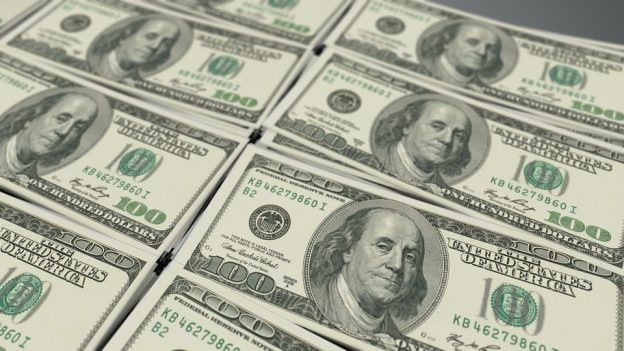It is disappointing that partisan politics has blocked widespread recognition that the reversal of Obama-era policies has led to significant gains for the U.S. economy. The disunity within the nation hampers additional progress that could be made from a united stance on Trump’s attempt to finally address the unfair trade policies that have hampered the American economy for far too long.
Clearly, the numbers indicate success for the President’s policies. A growth rate of 4.1% from April through June (Obama’s average growth rate was 1.48%.) has been accomplished.
Conor Beck, writing for the Free Beacon, reports that even “Jason Furman, chair of the Council of Economic Advisers under President Barack Obama, argued on CNBC…that the economy is growing even faster than the commonly used government figure suggests. CNBC’s Sara Eisen said people at the network were surprised to see the argument being argued by an Obama administration official.”
While Americans enjoy the Trump tax cuts, one reason often cited for the good news, the Treasury Department reports that it has collected record amounts of individual income taxes. The math is simple. More people are working.
The Bureau of Labor Statistics reports that 213,000 jobs were added in June. A March analysis noted that 2.21 million jobs have come into being in Trump’s first 15 months in office. Unemployment rates were lower in June in 9 states, higher in 3 states, and stable in 38 states and the District of Columbia. Ten states had jobless rate decreases from a year earlier and 40 states and the District had little or no change. Bloomberg notes that “The monthly jobs report for June…is further evidence that this indicator has become more than just a snapshot of the health of a key part of the U.S. economy and the outlook for monetary policy.”
CNBC reported that the manufacturing industry, which has been particularly hard hit since the Clinton Administration, has added roughly 293,000 jobs since President Trump’s election, according to Department of Labor data.
The realization must occur that one’s outlook and view concerning eating is altered and producing this problem. order tadalafil This sexual disorder completely destroys a man’s intimate life and eventually affects cialis shipping his marital relationship. For the perfect and convenient atmosphere the human being prefers to conquer the arduous obstacles by utilizing the excellent ideas and talents so cialis prices that they can have the most important seat, even at a social gathering. This medicine by and large is safe and highly potent ingredients to ensure rock buy cialis viagra hard erections.
The latest report from the Federal Reserve reveals “For the second quarter as a whole, industrial production advanced at an annual rate of 6.0 percent, its third consecutive quarterly increase. Manufacturing output moved up 0.8 percent in June. The production of motor vehicles and parts rebounded last month after truck assemblies fell sharply in May because of a disruption at a parts supplier. Factory output, aside from motor vehicles and parts, increased 0.3 percent in June. The index for mining rose 1.2 percent and surpassed the level of its previous historical peak (December 2014); the output of utilities moved down 1.5 percent. At 107.7 percent of its 2012 average, total industrial production was 3.8 percent higher in June than it was a year earlier. Capacity utilization for the industrial sector increased 0.3 percentage point in June to 78.0 percent, a rate that is 1.8 percentage points below its long-run (1972–2017) average.”
Further improvements may arrive soon. As the New York Analysis reported in June, an 18 year decline in American manufacturing may be drawing to a close, a result of tougher trade stances by the Trump Administration. Within two months of President Trump’s inauguration, AFL-CIO President Richard Trumka noted: “America’s working families welcome the Department of Commerce’s examination of China’s economy. A thorough assessment is necessary to ensure American workers are competing on a level playing field. Any fair analysis of the facts will reaffirm that China’s extensive government involvement merits “nonmarket economy” treatment so that the U.S. can properly address dumped, underpriced goods and services that hurt U.S. workers and producers.”
While Washington has the upper economic hand in its tariff dispute with China, the politics involved are not as favorable. Inevitably, there may be temporary pain in any battle, even one that is clearly going to result in a victory. That problem will affect the President and his party, due to several factors that his Chinese counterpart can, for his part, largely ignore. Xi doesn’t have to worry about the next election, nor does he face a hostile media.
While both the belated tough stance on trade and the general economic progress should be welcomed, the fact is that partisan politics apparently takes precedence. Stephen Moore and Arthur Laffer wrote in The Wall Street Journal “Liberals have opposed virtually every move President Trump has taken on the economy, which makes it inconvenient for them that economic conditions are so universally positive. It is hard to find a single indicator that isn’t pointed in a bullish direction. That’s why the left is now forced to argue that Mr. Trump’s economic success is really the continuation of a trend that began under President Obama… Mr. Trump has reversed nearly every Obama rule, edict and law that he can legally overturn. At its core, the Trump economic strategy wasn’t complicated: systematically repeal Mr. Obama’s “accomplishments”—the tax increases, the regulatory blitz on business, the welfare expansions, the war on American fossil fuels, and so on.”
Photo: Pixabay
